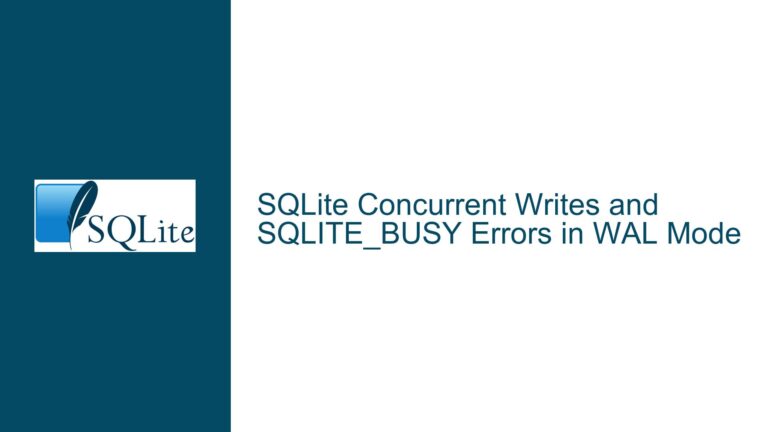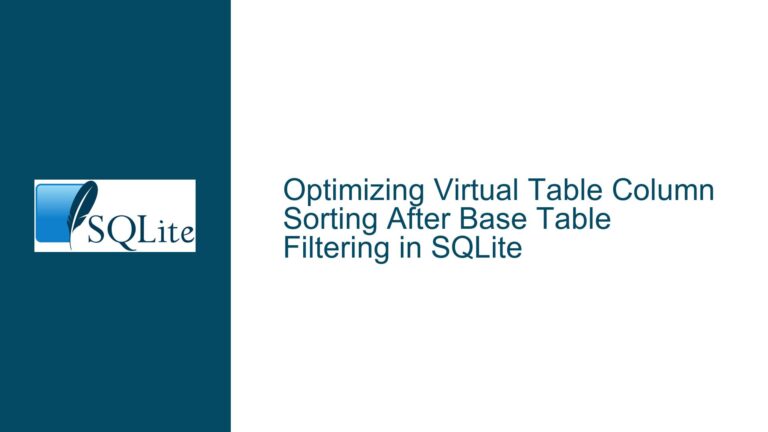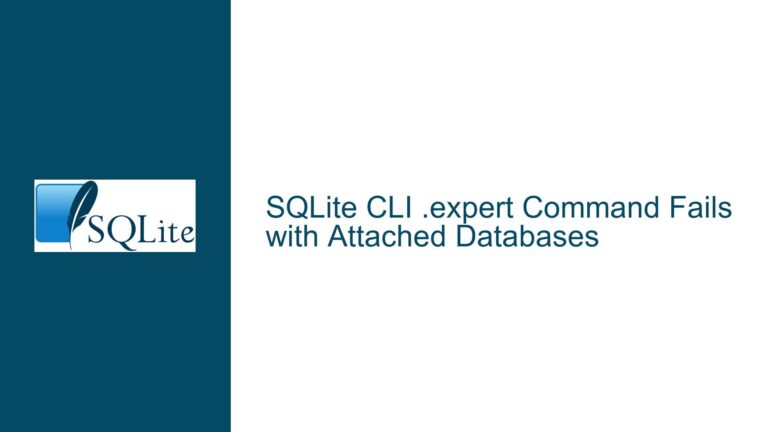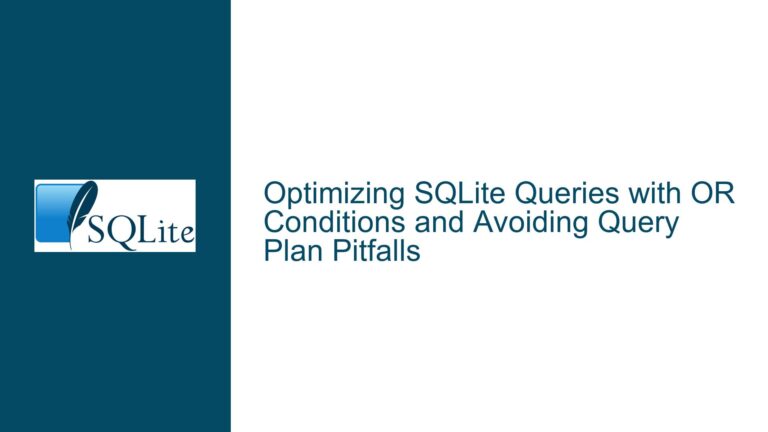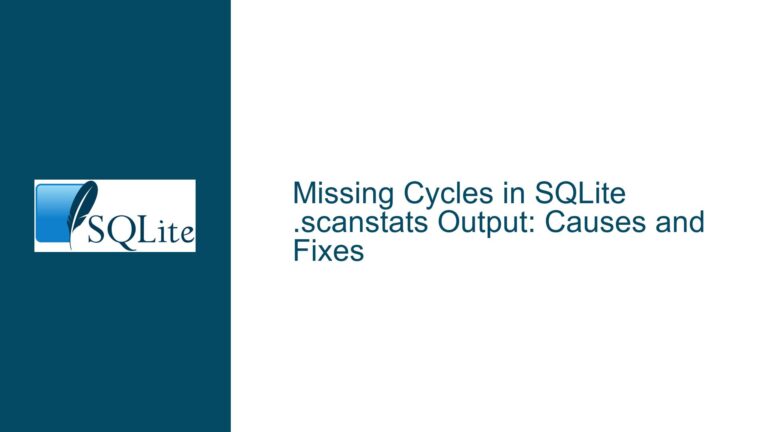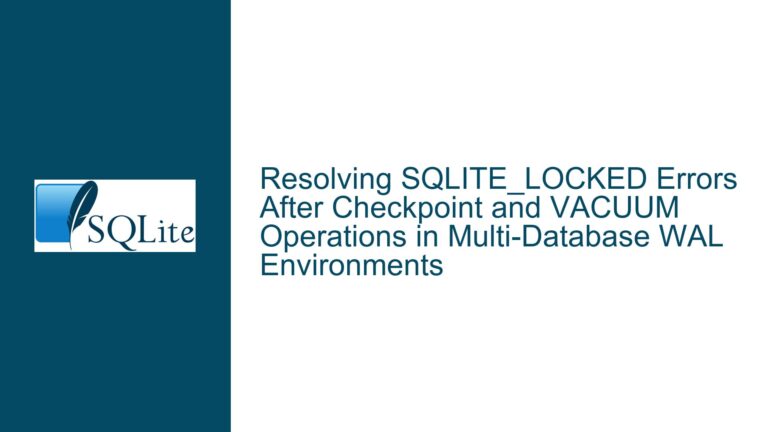SQLite Performance Issues on Amazon EFS: Network Latency and Caching Behavior
Understanding SQLite’s Caching Mechanism and Network File System Limitations
The core challenge revolves around SQLite’s interaction with network-attached storage systems like Amazon Elastic File System (EFS). While SQLite employs robust caching strategies for local storage, these mechanisms face fundamental limitations when operating on distributed file systems due to network latency, protocol overhead, and consistency verification requirements. This section dissects SQLite’s architecture in the context of network file systems, explaining why query execution times remain consistently high even with large cache allocations.
SQLite maintains an in-memory page cache (default size 2MB) that stores frequently accessed database pages. When a query executes, the engine first checks this cache before reading from disk. In local SSD scenarios, cache hits provide near-instantaneous response times (1ms in the observed case). However, EFS introduces a critical divergence: every disk access becomes a network operation governed by TCP/IP overhead and distributed file system protocols. Even when data exists in SQLite’s page cache, the database engine must perform mandatory consistency checks by reading the file header’s data_version field across the network. This 4-byte read operation incurs the full latency penalty of network round-trip communication, which typically dominates the total execution time.
The data_version check cannot be cached locally because multiple clients might modify the database concurrently on a shared file system. SQLite’s transaction model requires strict adherence to ACID principles, forcing it to verify the global state version before reusing cached pages. This creates a paradoxical situation where 99% of query processing occurs from memory, but the 1% network-dependent header check accounts for 90% of total latency. The xerial JDBC driver compounds this through connection management overhead – each query execution may involve separate JDBC statement handling that amplifies network chatter.
Critical Factors Impacting SQLite Performance on EFS
Three primary factors contribute to the observed performance characteristics:
Network Protocol Stack Overhead
Amazon EFS operates over NFSv4.1, which requires strict consistency guarantees. Every file operation (including lock acquisition and metadata checks) triggers multiple network round-trips between the EC2 instance and EFS servers. While SSD-backed EFS provides high throughput for large sequential accesses, small random I/O operations (common in SQLite’s page management) suffer disproportionately from TCP connection setup and NFS protocol negotiation latency. A single 4KB page read may incur 20ms+ latency compared to 0.01ms on local NVMe storage.Locking and Concurrency Management
SQLite employs file-level and byte-range locking to manage concurrent access. On local filesystems, these operations are atomic and near-instantaneous. When using EFS, each lock acquisition requires communication with the NFS server cluster. The default locking_mode (NORMAL) performs shared lock upgrades during writes, generating multiple network requests per transaction. Even read-only queries trigger shared lock acquisitions that must propagate through the distributed file system.Cache Validation Requirements
SQLite’s page cache validation process mandates checking the database header’s data_version counter after the first query execution. This 4-byte read occurs via the PRAGMA data_version command or implicit header access, forcing a network round-trip regardless of cache hit rates. Subsequent queries cannot skip this verification because EFS doesn’t provide strong client-side caching guarantees – another client might have modified the database through a different mount point.
Optimizing SQLite for Network-Attached Storage Environments
1. Locking Mode Configuration
Set exclusive locking at connection open to minimize network chatter:
PRAGMA locking_mode = EXCLUSIVE;
This acquires an exclusive file lock during the first read operation and holds it until connection closure. While this prevents concurrent write access, it eliminates per-transaction lock negotiation overhead. Combine with:
PRAGMA journal_mode = MEMORY;
To store rollback journals in RAM rather than flushing to EFS. For read-only workloads:
PRAGMA query_only = 1;
Disables all locking mechanisms entirely.
2. Cache and Memory Optimization
Dramatically increase page cache size to minimize disk fetches:
PRAGMA cache_size = -1000000; -- 1GB cache in KiB units
Utilize memory-mapped I/O for predictable access patterns:
PRAGMA mmap_size = 1073741824; -- 1GB mmap
Disable memory protection barriers that trigger unnecessary syncs:
PRAGMA wal_autocheckpoint = 0;
3. Network Latency Mitigation
Configure the EFS mount with aggressive read-ahead and attribute caching:
mount -t efs -o rw,rsize=1048576,wsize=1048576,hard,timeo=600,retrans=3,noresvport fs-id:/ /mnt/efs
Implement a local caching proxy using cachefilesd for Linux instances:
# /etc/cachefilesd.conf
brun 10%
bcull 7%
bstop 3%
frun 10%
fcull 7%
fstop 3%
dir /var/cache/fscache
tag mycache
Mount EFS with fsc option:
mount -t efs -o fsc,rsize=1048576 fs-id:/ /mnt/efs
4. JDBC Driver Tuning
Configure the xerial driver with connection pooling and statement caching:
SQLiteConfig config = new SQLiteConfig();
config.setCacheSize(1000000);
config.setLockingMode(LockingMode.EXCLUSIVE);
config.setSynchronous(SynchronousMode.OFF);
DataSource ds = new SQLiteDataSource(config);
5. Alternative Architectures
For write-intensive workloads, implement a tiered storage architecture:
- Maintain a local SQLite instance on EC2 ephemeral storage
- Replicate changes to EFS via
sqlite3_backupAPI hourly - Use S3 lifecycle policies for long-term archival
For read-heavy scenarios, preload databases into RAM disk:
mkdir /mnt/sqlite_ram
mount -t tmpfs -o size=2g tmpfs /mnt/sqlite_ram
cp /mnt/efs/db.sqlite /mnt/sqlite_ram/
6. Monitoring and Diagnostics
Use Linux perf to trace system calls:
perf trace -e 'syscalls:sys_enter_*' java -jar app.jar
Monitor EFS client metrics via CloudWatch:
- MetadataLatency
- DataReadLatency
- TotalIOBytes
Enable SQLite’s internal profiling:
SQLiteConnection.addLogger(new SQLiteLogger() {
public void log(String message) {
System.out.println(message);
}
});
Through comprehensive configuration tuning, architectural adjustments, and deep understanding of NFSv4 protocol characteristics, SQLite can achieve sub-5ms query latencies on EFS for cached workloads. However, mission-critical applications requiring microsecond response times should consider alternative database engines designed for distributed storage or implement local caching layers with asynchronous EFS synchronization.

